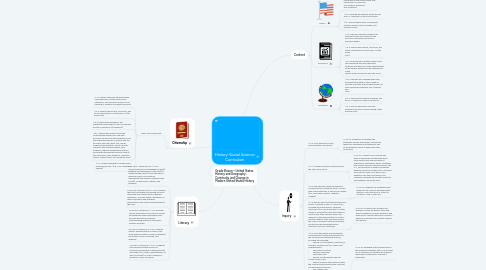
1. Citizenship
1.1. Civics and Government
1.1.1. 11.4.4. Explain Theodore Roosevelt’s Big Stick diplomacy, William Taft’s Dollar Diplomacy, and Woodrow Wilson’s Moral Diplomacy, drawing on relevant speeches.
1.1.2. 11.4.5. Analyze the political, economic, and social ramifications of World War I on the home front.
1.1.3. 11.5.3. Examine the passage of the Eighteenth Amendment to the Constitution and the Volstead Act (Prohibition).
1.1.4. 11.6.4. Analyze the effects of and the controversies arising from New Deal economic policies and the expanded role of the federal government in society and the economy since the 1930s (e.g., Works Progress Administration, Social Security, National Labor Relations Board, farm programs, regional development policies, and energy development projects such as the Tennessee Valley Authority, California Central Valley Project, and Bonneville Dam).
1.1.5. 11.7.4. Analyze Roosevelt’s foreign policy during World War II (e.g., Four Freedoms speech).
2. Literacy
2.1. CCSS.ELA-Literacy.WHST.11-12.1a. Introduce precise, knowledgeable claim(s), establish the significance of the claim(s), distinguish the claim(s) from alternate or opposing claims, and create an organization that logically sequences the claim(s), counterclaims, reasons, and evidence.
2.2. CCSS.ELA-Literacy.WHST.11-12.2b. Develop the topic thoroughly by selecting the most significant and relevant facts, extended definitions, concrete details, quotations, or other information and examples appropriate to the audience’s knowledge of the topic.
2.3. CCSS.ELA-Literacy.RH.11-12.3. Evaluate various explanations for actions or events and determine which explanation best accords with textual evidence, acknowledging where the text leaves matters uncertain.
2.4. CCSS.ELA-Literacy.RH.11-12.6. Evaluate authors’ differing points of view on the same historical event or issue by assessing the authors’ claims, reasoning, and evidence.
2.5. CCSS.ELA-Literacy.RH.11-12.7. Integrate and evaluate multiple sources of information presented in diverse formats and media (e.g., visually, quantitatively, as well as in words) in order to address a question or solve a problem.
3. Grade Eleven – United States History and Geography: Continuity and Change in Modern United States History
4. Content
4.1. History
4.1.1. 11.3.3. Cite incidences of religious intolerance in the United States (e.g., persecution of Mormons, anti-Catholic sentiment, anti-Semitism).
4.1.2. 11.4.2. Describe the Spanish-American War and U.S. expansion in the South Pacific.
4.1.3. 11.5.1. Discuss the policies of Presidents Warren Harding, Calvin Coolidge, and Herbert Hoover
4.2. Economics
4.2.1. 11.2.5. Discuss corporate mergers that produced trusts and cartels and the economic and political policies of industrial leaders
4.2.2. 11.4.5. Analyze the political, economic, and social ramifications of World War I on the home front.
4.2.3. 11.6.1. Describe the monetary issues of the late nineteenth and early twentieth centuries that gave rise to the establishment of the Federal Reserve and the weaknesses in key sectors of the economy in the late 1920s.
4.3. Geography
4.3.1. 11.2.2. Describe the changing landscape, including the growth of cities linked by industry and trade, and the development of cities divided according to race, ethnicity, and class.
4.3.2. 11.4.2. Describe the Spanish-American War and U.S. expansion in the South Pacific.
4.3.3. 11.4.3. Discuss America’s role in the Panama Revolution and the building of the Panama Canal.
5. Inquiry
5.1. 11.2.3. Trace the effect of the Americanization movement.
5.1.1. H-SS AS: Students can compare the strategies used by businesses in employing these two organizational strategies as well as the potential impact it would have upon consumers.
5.2. 11.4.1. List the purpose and the effects of the Open Door policy.
5.2.1. H-SS AS: Students may consider the nation’s objectives and attitudes about other nations and diverse people in analyzing its immigration policy, limitations and scrutiny placed on those already in the U.S., and exclusion of people considered disabled, as well as foreign policy, including the American Open Door policy, and expansion into the South Pacific and Caribbean following the Spanish-American and Philippine-American Wars.
5.3. 11.5.5. Describe the Harlem Renaissance and new trends in literature, music, and art, with special attention to the work of writers (e.g., Zora Neale Hurston, Langston Hughes).
5.3.1. H-SS AS: Students can synthesize their studies of the 1920s by addressing this question: Were the 1920s a “return to normalcy?” Why or why not?
5.4. 11.7.5. Discuss the constitutional issues and impact of events on the U.S. home front, including the internment of Japanese Americans (e.g., Fred Korematsu v. United States of America) and the restrictions on German and Italian resident aliens; the response of the administration to Hitler’s atrocities against Jews and other groups; the roles of women in military production; and the roles and growing political demands of African Americans.
5.4.1. H-SS AS: Students can consider this question in order to identify cause and effect changes for ordinary people on the home front: How did World War II serve to advance movements for equality at home and abroad?
5.5. 11.9.3. Trace the origins and geopolitical consequences (foreign and domestic) of the Cold War and containment policy, including the following: • The era of McCarthyism, instances of domestic Communism (e.g., Alger Hiss) andblacklisting • The Truman Doctrine • The Berlin Blockade • The Korean War • The Bay of Pigs invasion and the Cuban Missile Crisis • Atomic testing in the American West, the “mutual assured destruction” doctrine, and disarmament policies • The Vietnam War • Latin American policy
5.5.1. H-SS AS: Equipped with a background on the differences between the US and Soviet Union, students can address this question: What was Containment? How was it employed?
